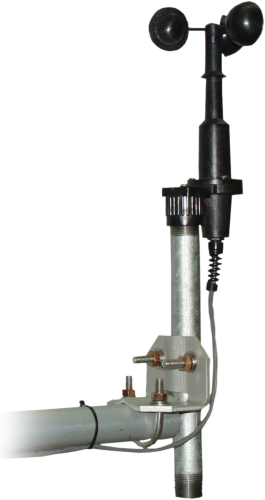The Role of an Anemometer in Improving Safety for Outdoor Activities
The Role of an Anemometer in Improving Safety for Outdoor Activities
Blog Article
Discovering the Features and Advantages of Anemometers for Climate Fanatics and Specialists
From mug anemometers to sonic anemometers, each kind brings its distinct collection of applications and advantages, losing light on numerous elements of climatic conditions. As we delve right into the functions and advantages of anemometers, a deeper understanding arises not only of dominating weather condition sensations yet also of the wider effects for fields like wind power production and ecological research.
Importance of Anemometers in Weather Surveillance
Anemometers play an essential duty in weather condition monitoring by supplying accurate dimensions of wind speed, helping in projecting and understanding weather condition patterns. These tools, ranging from traditional cup anemometers to modern-day ultrasonic anemometers, are necessary for meteorologists, researchers, and weather condition enthusiasts alike. By determining wind speed, anemometers assist in determining the strength of climate phenomena such as tornadoes, tornados, and typhoons. In addition, they supply beneficial data for air travel, maritime procedures, and different markets that are delicate to wind problems.

Kinds of Anemometers and Their Applications
The most typical kinds of anemometers include mug anemometers, vane anemometers, hot-wire anemometers, and ultrasonic anemometers. Cup anemometers consist of 3 or four mugs installed on straight arms that revolve with the wind, measuring its speed. Vane anemometers, on the other hand, use a freely rotating vane to straighten with the wind direction, giving both wind speed and instructions measurements.
Each kind of anemometer has its special advantages and applications. Mug anemometers are appropriate and durable for basic climate monitoring, while vane anemometers are favored for directional dimensions. Hot-wire anemometers are delicate to reduced air speeds, making them suitable for indoor settings. Ultrasonic anemometers are non-intrusive and provide high accuracy, frequently utilized in study and specialized weather condition surveillance applications. Understanding the attributes and applications of each kind of anemometer is crucial for choosing one of the most appropriate instrument for certain weather checking needs.
Benefits of Making Use Of Anemometers in Projecting
In weather forecasting, the application of anemometers supplies very useful benefits for boosting the precision of weather condition forecasting. Anemometers measure wind speed and instructions, providing crucial data for predicting weather patterns. By including wind information right into forecasting models, meteorologists can better recognize the activity of climate systems, expect modifications in weather, and problem much more accurate forecasts.
Moreover, anemometers play a vital duty in analyzing possible weather condition risks. Keeping track of wind speeds aids forecasters anticipate extreme weather condition occasions such as cyclones, twisters, and winter tornados with greater precision. This early caution system allows authorities to issue prompt alerts and apply required safety procedures, decreasing the threats to life and home.
Additionally, anemometers aid in optimizing renewable resource manufacturing. By analyzing wind patterns, meteorologists can determine suitable places for wind Get More Info ranches and predict energy output, adding to the efficient generation of wind power.

Anemometers in Wind Energy Manufacturing
Given the important function anemometers play in providing exact wind data for climate projecting and threat evaluation, their importance includes the realm of wind power manufacturing. Anemometers are vital instruments in the field of wind energy, where the dimension of wind rate and direction is critical for determining the expediency and performance of wind generator installments. By precisely determining wind speeds at varying heights, anemometers assist enhance the positioning and design of wind turbines to maximize energy output.
In wind ranches, anemometers are strategically placed to gather real-time wind information that is made use of to analyze the possible power manufacturing of a website. This data is important in figuring out the economic practicality of wind energy projects and in projecting power generation to make sure grid security. Furthermore, anemometers help in keeping an eye on wind conditions to optimize turbine efficiency, protect against damages from high winds, and guarantee the security of personnel operating in the vicinity of wind generators.
Enhancing Weather Understanding With Anemometers

Anemometers play an essential function in improving our understanding of microclimates. These localized climate condition can vary significantly from broader regional projections, making it vital to have exact information for certain locations. anemometer. By tactically putting anemometers in various locations, scientists can collect in-depth information on how wind acts in different terrains, city settings, or bodies of water
In addition, anemometers add to enhancing weather projecting designs by giving real-time information on wind habits. This information is particularly beneficial for anticipating severe climate occasions, enhancing agricultural practices, and sustaining markets like aviation and maritime navigating. On the whole, anemometers are very useful tools that allow us to dive deeper right into the complexities of climate systems, eventually leading to even more accurate forecasts and better-informed decisions.
Verdict
In final thought, anemometers play a vital role in climate monitoring and forecasting by determining wind rate and direction. They are important tools used by climate fanatics and experts to collect precise information for predicting weather condition patterns and assessing prospective impacts. Anemometers also have applications in wind power production, additional highlighting their significance in both weather forecasting and renewable resource fields. Overall, anemometers contribute to enhancing our understanding of climate sensations and improving projecting capacities. anemometer.
From mug anemometers to sonic anemometers, each type brings its one-of-a-kind collection of applications and advantages, shedding light on various elements of climatic problems. These tools, varying from typical mug click here to find out more anemometers to modern-day ultrasonic anemometers, are important for meteorologists, researchers, and climate enthusiasts alike. The most common types of anemometers include mug anemometers, vane anemometers, hot-wire anemometers, and ultrasonic anemometers. Mug anemometers are durable and ideal for basic climate monitoring, while vane anemometers are favored for directional dimensions. Anemometers are important instruments in the field of wind power, where the measurement of wind speed and direction is essential for figuring out the expediency and effectiveness of wind turbine installations.
Report this page